Overview
Basin Electric Power Cooperative (Basin Electric) was incorporated under the laws of the State of North Dakota in 1961 as a not-for-profit generation and transmission (G&T) cooperative corporation. We are headquartered in Bismarck, North Dakota, and are principally engaged in the business of providing wholesale electric services to our member cooperatives (members). These electric services generally represent the capacity and energy requirements of our members beyond what is available to our members from other sources, primarily the Western Area Power Administration, an agency of the United States Department of Energy, that provides hydroelectric power on a preferential basis to our members. We serve our members’ power requirements pursuant to long-term wholesale power contracts. Through our members, we provide electric service to approximately 3 million consumers in the states of Colorado, Iowa, Minnesota, Montana, Nebraska, New Mexico, North Dakota, South Dakota, and Wyoming.
We employ an all-of-the-above energy strategy to supply our members’ power requirements. Basin Electric’s portfolio of power supply resources includes owned generation, long-term power purchase contracts, short-term, and spot market energy purchases. Our generating resources are fueled by a mix of natural gas, coal, wind, hydro, solar, and fuel oil.
We participate in the following energy markets: Midcontinent Independent System Operator (MISO) and the Southwest Power Pool (SPP) in the Eastern Interconnection. In the Western Interconnection, our load and assets participate in energy imbalance markets of SPP’s Western Energy Imbalance Service market and California Independent System Operator’s Western Energy Imbalance Market through various transmission providers.
We are owned entirely by our members, who are the primary purchasers of the power we sell. Basin Electric has 140 members composed of four membership classifications.
In general, a cooperative is a business organization owned by its members, that are also either the cooperative’s wholesale or retail customers. Cooperatives are organized to give their members the opportunity to satisfy their collective needs in a particular area of business more effectively than if the members acted independently. As not-for-profit organizations, cooperatives are intended to provide services to their members on a cost-effective basis, in part by eliminating the need to produce a return on equity in excess of required margins. Margins earned by a cooperative that are not distributed to its members constitute patronage capital, a cooperative’s principal source of equity. Patronage capital is held on behalf of the members without interest and returned when the board of directors of the cooperative deems it appropriate to do so.
Basin Electric has three wholly owned, for-profit subsidiaries: Dakota Gasification Company, Dakota Coal Company, and Nemadji River Generation LLC. Dakota Gas converts lignite coal into pipeline-quality synthetic natural gas, carbon dioxide, anhydrous ammonia, urea, diesel exhaust fluid, and a variety of other products. Dakota Coal provides coal for our Antelope Valley Station, Leland Olds Station, and Great Plains Synfuels Plant. Nemadji River Generation is the owner of a 30% undivided interest in the Nemadji Trail Energy Center project. The Nemadji Trail project is a proposed 600-megawatt (MW), natural gas-fueled combined-cycle electric generation facility in Superior, Wisconsin.
Members
Basin Electric is part of a three-tiered electric cooperative system. The top tier consists of 120 distribution cooperatives and municipal utilities. These members are the “last mile of line” that provide electric service to approximately 3 million consumers in our nine-state service area. The distribution cooperatives are owned by their end-use consumers and their boards are composed of end-use consumers democratically elected by other end-use consumers. The second tier consists of 11 districts (Class A members), 10 of which are G&T cooperatives whose membership is composed of distribution cooperatives and municipal utilities. The remaining district, while not a G&T cooperative itself, is composed of nine distribution cooperatives and one municipal utility association. The G&T cooperatives are owned by their members and their boards are elected by their members. Each of these 11 districts is represented on Basin Electric’s board. Basin Electric is the third tier of this cooperative system.
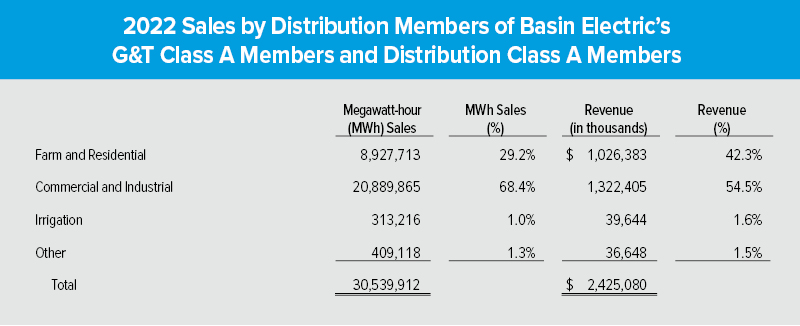
We have four membership classifications:
- Our Class A members consist of 10 wholesale G&T cooperatives, eight distribution cooperatives, and one wholesale municipal provider that have entered into long-term wholesale power contracts with us (the “Class A members”). Our Class A members have service areas in Colorado, Iowa, Minnesota, Montana, Nebraska, New Mexico, North Dakota, South Dakota, and Wyoming. We supply power directly to and receive revenue directly from our Class A members. Electric sales to our Class A members comprised approximately 85% of our revenue from electric sales in 2023.
- Our Class B members consist of any municipality or association of municipalities operating within an area served by a Class A member and which is a member of and contracts for its electric capacity or energy from that Class A member (the “Class B members”). We currently have one Class B member. We do not supply power directly to or receive revenue directly from our Class B member.
- Our Class C members consist of distribution cooperatives and public power districts that are members of our G&T Class A members (the “Class C members”). Our Class C members do not purchase power directly from us, but rather from their respective G&T Class A members. We currently have 119 Class C members. We do not supply power directly to or receive revenue directly from our Class C members.
- Our Class D members consist of electric cooperatives that purchase power directly from us as a member on a basis other than on an all-supplemental requirements basis that we have with our Class A members (the “Class D members”). We currently have one Class D member.
Our members that are distribution cooperatives and municipal utilities provide electric services to residential, farm, commercial, industrial, and irrigation end-use consumers. Our members serve major industries that include oil and gas, pipelines, ethanol production, mining, livestock, and agriculture. The table below shows energy sales and revenue by customer class for the year 2022 (the latest year information is available) for the distribution members of our G&T Class A members and our distribution Class A members.
Wholesale Power Contracts
Our financial relationships with our Class A members are defined by wholesale power contracts for the sale of capacity and energy. Our wholesale power contracts with our Class A members extend through 2075, with the exception of our wholesale power contracts with Tri-State G&T, Minnesota Valley Electric Cooperative, Wright-Hennepin Cooperative Electric Association, and Wyoming Municipal Power Agency, which extend through 2050. In 2023, revenues from electric sales to members with wholesale power contracts expiring in 2050 were approximately 10% of our total member sales. Some of our Class A members are G&T cooperatives with membership comprising our Class B and C members. With limited exceptions, the wholesale power contracts our Class A members have with their members extend through similar dates as our contracts with Class A members.
Rate Regulation of Members
Of the nine states in our service territory, two (Colorado and Wyoming) have statutes providing for the regulation of rates of electric distribution cooperative associations operating on an intra-state basis. The distribution members of our G&T Class A members located in Wyoming are subject to rate regulation by the respective state regulatory authorities. In Colorado, legislation in 1983 gave distribution cooperatives the option, by the affirmative vote of a majority of their membership prior to July 1, 1984, to avoid rate regulation by the Colorado Public Utilities Commission. All but one of our Class C members in Colorado chose to do so. In addition to the state rate regulation of the distribution cooperatives of several G&T Class A members, Class A members Upper Missouri Power Cooperative and Tri-State G&T are subject to rate regulation by the Federal Energy Regulatory Commission (FERC).
Power Supply
In 2023, we sold our members 32.1 million megawatt-hours (MWh) of energy and our billing system peak was 4,702 MW. To satisfy these requirements, we own or lease a diversified portfolio of generation assets, as depicted on page 26. In addition, we own approximately 2,500 miles of high-voltage transmission lines. The power requirements not met by our owned or leased resources are obtained from multiple suppliers under various long-term, short-term, and spot market purchases of energy and capacity.
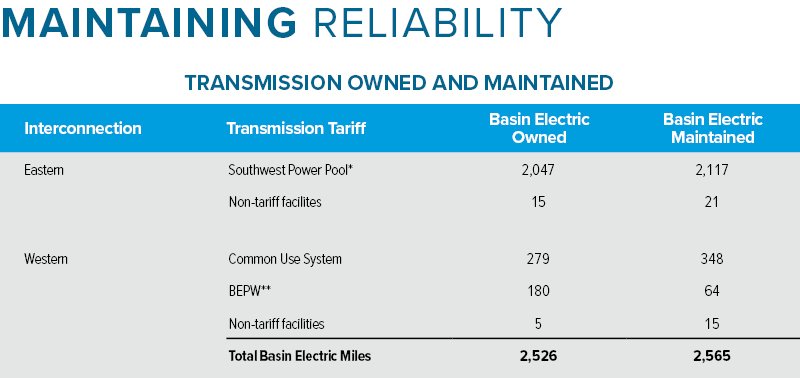
In addition to our owned transmission facilities, we rely on a variety of transmission systems to serve our members’ power requirements. The electric transmission system in the United States is separated into two major alternating current electrical power grids, the Eastern Interconnection and the Western Interconnection. The most significant effect of this separation is a limited power-transfer capability from one interconnection to the other. We provide service to our members located in both the Eastern Interconnection and the Western Interconnection; as such, Basin Electric has access to several DC ties.
In the Eastern Interconnection we are members of SPP and MISO, both regional transmission organizations. In the Western Interconnection our transmission needs are satisfied through:
- The Common Use System, a joint transmission system between, Black Hills Power, Powder River Energy Corporation, and Basin Electric;
- Basin Electric’s West side transmission tariff that includes Basin Electric’s Western Interconnection Missouri Basin Power Project transmission facilities; and
- Various transmission contracts we have entered into with the Western Area Power Administration and others.
In 2023, approximately 74.9% of our member MWh sales were in the SPP Integrated Marketplace, 9.5% in MISO’s energy market, and 15.6% in the Western Interconnection.
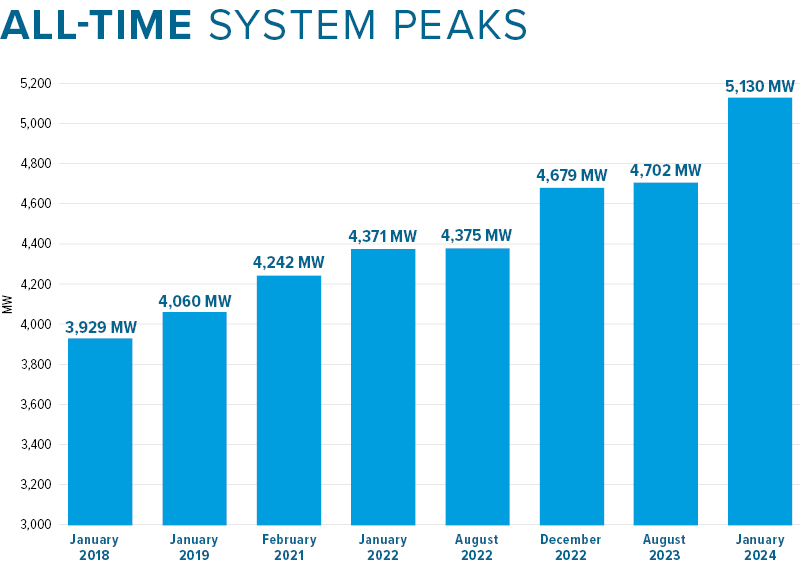
Investing in Facilities
Basin Electric plans to make major investments into critical generation and transmission facilities in the next five years to ensure our members continue to receive the reliable electricity they depend on. Basin Electric’s board of directors approves all projects with budgets of more than $1 million. The information below shows planned investments in new generation and transmission and the upgrades at existing facilities, for projects approved through March 2024.
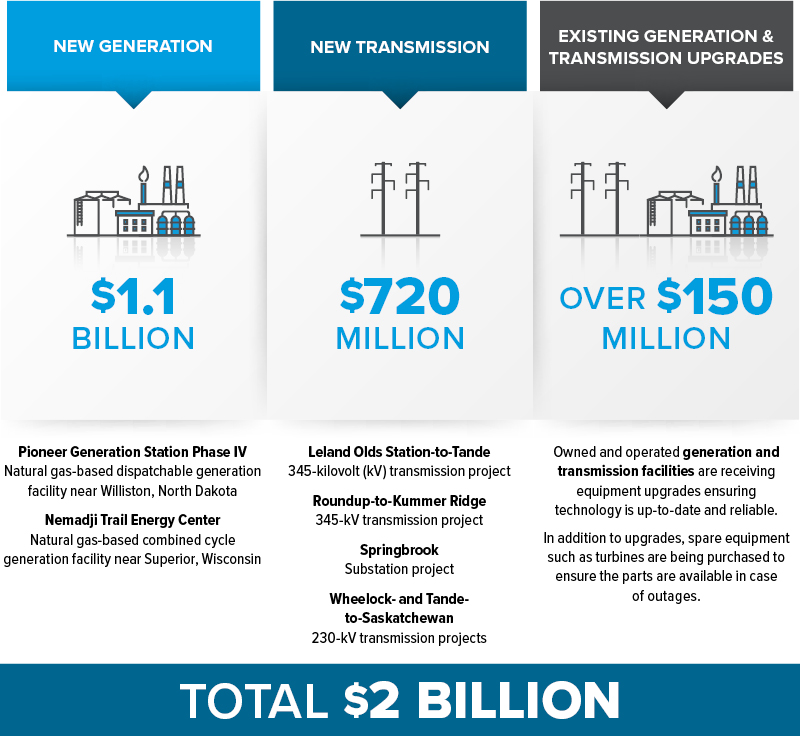
Rate Regulation
We provide electric power to our Class A members at rates established by our board of directors. Our wholesale power contracts with our Class A members provide that the board shall establish sufficient rates, with our revenues from all other sources, to meet the costs of operation and maintenance of the generating plants, transmission system, and related facilities, the cost of any power and energy purchased for resale by us, the cost of transmission service, the cost of lease payments, interest expense, depreciation expense or principal repayments, and to provide for the establishment and maintenance of reasonable reserves.
Since 2019, we have been subject to regulation as a “public utility” by FERC under the Federal Power Act. As an entity subject to regulation as a “public utility” by FERC, our rates to our members are subject to FERC approval. In addition, we must obtain prior FERC approval to incur indebtedness and sell assets above a certain threshold.
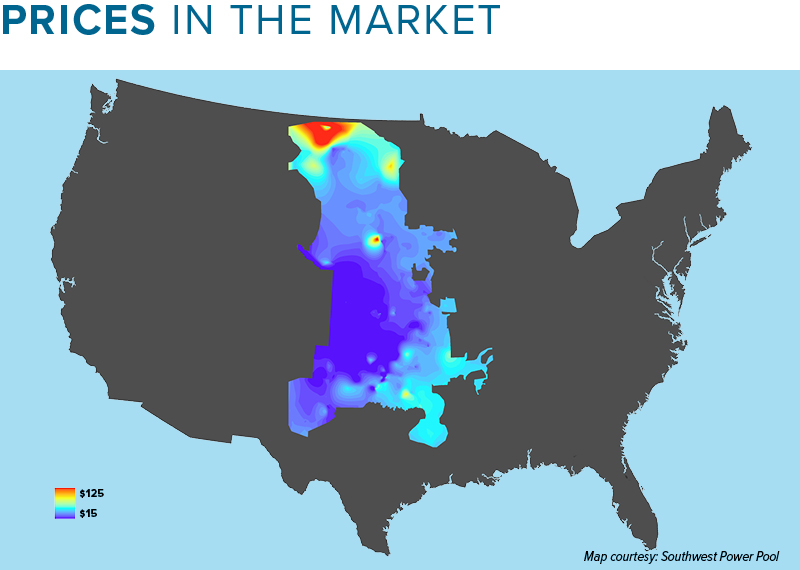 This map depicts annual simple average day-ahead market pricing in Southwest Power Pool in 2023. Without going into technical details, the red shows where congestion is causing high market pricing in Basin Electric’s service area. Investment in transmission lines, substations, and generation facilities in western North Dakota is part of the solution to help relieve this congestion as member load growth continues.
This map depicts annual simple average day-ahead market pricing in Southwest Power Pool in 2023. Without going into technical details, the red shows where congestion is causing high market pricing in Basin Electric’s service area. Investment in transmission lines, substations, and generation facilities in western North Dakota is part of the solution to help relieve this congestion as member load growth continues.
